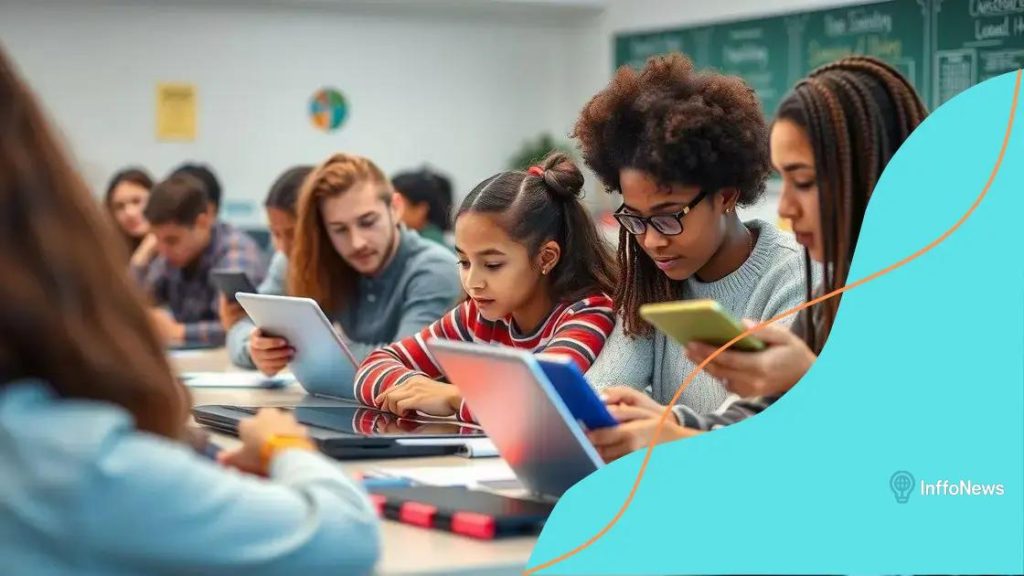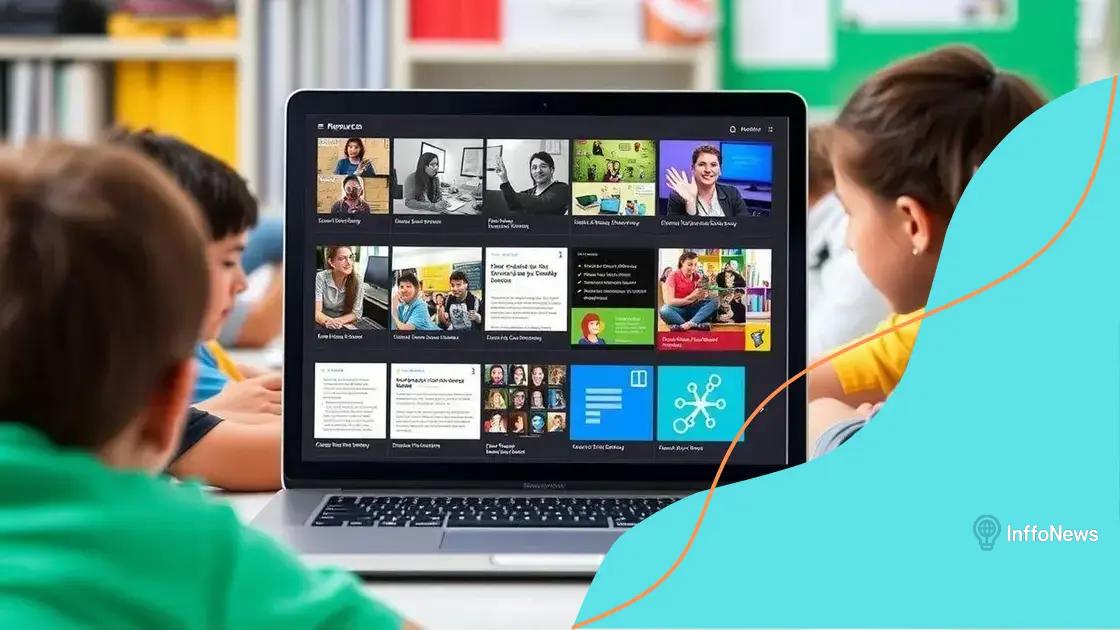Impact of technology on learning styles and education

Anúncios
The impact of technology on learning styles enhances personalized education through tools like AI and VR, which cater to diverse learning preferences while also presenting challenges such as access and distraction.
The impact of technology on learning styles is profound, influencing how we absorb information daily. Ever wondered how tools like apps or online courses shift our preferences? Let’s dive into this engaging topic.
Anúncios
Understanding different learning styles
Understanding different learning styles is essential in utilizing technology effectively in education. Each learner has unique preferences, which makes it crucial to cater to these differences. In today’s classrooms, technology plays a significant role in helping students learn in ways that fit their needs.
What are learning styles?
Learning styles refer to the various ways individuals prefer to process information. Recognizing these styles can greatly enhance the learning experience. Some common learning styles include:
- Visual learners: They learn best through images, diagrams, and charts.
- Auditory learners: These learners grasp information better when they hear it, such as through lectures or discussions.
- Kinesthetic learners: They prefer hands-on experiences and learn by doing.
By integrating technology, educators can support each of these learning styles. For instance, visual learners can benefit from interactive video content, while auditory learners may find podcasts and audio lessons helpful.
Anúncios
The role of technology
Technology allows for the personalization of learning experiences. For example, adaptive learning software tailors lessons to match a student’s specific learning style and pace. This capability can inspire student engagement and foster a deeper understanding of the material.
Moreover, technology provides access to vast resources. Students can use online tools to explore topics through video, text, and interactive simulations. This multidimensional approach effectively addresses diverse learning styles.
It’s also important to mention the challenges. With numerous tools available, educators must select resources that align effectively with their teaching strategies. Moreover, there can be difficulties for students who struggle with technology. Therefore, ongoing support and clear instructions become essential.
In exploring learning styles, it’s vital to remember that they can change over time. As students grow and develop, their preferences might shift. Thus, a flexible approach in teaching and adapting technology is essential to address learning styles throughout their educational journey.
How technology personalizes education
Technology personalizes education by catering to individual learning needs. With tools like adaptive software, educators can tailor lessons for each student. This approach not only motivates learners but also helps them grasp concepts at their own pace.
Adaptive Learning Systems
Adaptive learning systems are one of the best examples of personalization in education. These platforms assess a student’s strengths and weaknesses, adjusting the curriculum accordingly. For instance, if a student struggles with math concepts, the software can provide additional practice tailored to their specific needs.
- Real-time feedback: Students receive immediate feedback which helps them understand where they need improvement.
- Customized learning paths: Each learner follows a unique path designed for their pace and comprehension level.
- Engaging content: Personalized resources keep students interested and motivated to learn.
Beyond adaptive systems, technology offers tools like online quizzes and gamified learning. These resources provide instant results, making learning more interactive. For instance, gamification elements lead to greater student engagement and turn lessons into exciting challenges.
Data-Driven Insights
Technology also allows educators to gather data on student performance. By analyzing this data, teachers can identify trends and adapt instruction to fit the needs of the class. For example, if a majority of students perform poorly on a specific topic, the teacher can adjust their approach to clarify misunderstandings.
Additionally, technology can facilitate collaborative learning. Online platforms allow students to work on group projects, even if they are not in the same physical space. This fosters peer-to-peer learning and enables students to learn from each other’s strengths.
As education continues to evolve, technology plays a crucial role in personalizing learning experiences. In the process, it enhances the overall educational landscape, ensuring that each student can thrive according to their unique learning style.
The role of online resources

The role of online resources in education has grown significantly, especially in recent years. These resources provide students with access to vast information and learning tools, enhancing their educational experience.
Types of Online Resources
Online resources come in various formats, making it easier for students to find what works best for their learning style. Some popular types include:
- Educational websites: Sites like Khan Academy and Coursera offer free courses on a wide range of topics.
- Digital libraries: Platforms such as Google Scholar and JSTOR provide access to academic articles and publications.
- Video tutorials: Websites like YouTube host channels dedicated to teaching various subjects, making learning visual and engaging.
By incorporating these resources, teachers can create a blended learning environment that complements traditional teaching methods. This approach supports diverse learning styles and fosters engagement among students.
Advantages of Online Resources
Online resources offer many advantages that enhance the learning process. One major benefit is the flexibility they provide. Students can learn at their own pace, revisiting materials whenever necessary. This autonomy boosts confidence and helps students master challenging concepts.
Additionally, online resources encourage collaboration among students. Platforms like Google Classroom allow groups to work together on projects, exchange ideas, and share feedback. This interactive aspect cultivates a sense of community, even in virtual settings.
Another key aspect is the ability to cater to different learning preferences. Some students may prefer reading articles, while others thrive with video content. Online resources offer a variety of formats, ensuring that all learners can find materials that fit their needs.
As technology continues to advance, the role of online resources in education will only become more vital. Leveraging these tools can create more engaging, personalized, and effective learning experiences for students of all ages.
Challenges of technology in learning
While technology greatly enhances learning, it also presents several challenges for educators and students. Recognizing these challenges is essential to creating effective strategies that harness the benefits of technology.
Access and Equity
One of the primary obstacles is access to technology. Not all students have the same resources, which can lead to inequities in learning opportunities. Some may struggle to keep up if they lack devices or reliable internet.
- Digital divide: Many students face barriers due to economic disparities, impacting their ability to participate fully in online learning.
- Technical challenges: Students might not have access to necessary software or tools, limiting their learning potential.
- Support systems: A lack of guidance on using technology can hinder student success.
These challenges highlight the importance of creating inclusive environments where all students can thrive regardless of their background.
Distraction and Engagement
Another issue is the potential for distraction. With the vast array of apps and websites available, students can easily drift away from educational content. Adjusting to this new environment can be difficult.
Teachers often find it challenging to keep students engaged when learning through screens. The lack of face-to-face interaction may lead to decreased motivation. To combat this, interactive and engaging content is necessary to draw students back.
Furthermore, it’s crucial to promote digital citizenship. Teaching students how to use technology responsibly can help reduce distractions and increase focus on learning.
Instructional Strategies
Teachers may struggle to adapt their instructional strategies for technology-rich classrooms. Many traditional methods may not effectively translate to online or hybrid learning environments.
To mitigate this, educators need professional development and support to learn how to use technology effectively in their teaching. Ongoing training can empower them to leverage tools that enhance learning.
By addressing these challenges, educators can create a more balanced and effective learning environment that utilizes technology’s strengths while minimizing its weaknesses.
Future trends in educational technology
Future trends in educational technology are set to transform the way students learn and teachers instruct. As technology evolves, it continues to shape educational practices, making learning more interactive, personalized, and accessible.
Artificial Intelligence in Education
One of the most exciting advancements is the integration of artificial intelligence (AI) in classrooms. AI tools can analyze student performance data and adapt learning materials to meet individual needs. This personalization helps students learn at their own pace, ensuring they fully grasp concepts before moving on.
- Smart tutoring systems: AI-driven platforms can offer tailored instructional support, providing explanations and practice exercises based on a student’s unique challenges.
- Predictive analytics: This technology analyzes historical data to predict future performance, helping educators identify students who may need additional support.
- Automated grading: AI can assist teachers by quickly grading assignments and providing feedback, allowing them more time to focus on teaching.
This technological shift is crucial for fostering a more efficient and engaged learning environment.
Virtual and Augmented Reality
Another trend gaining traction is the use of virtual reality (VR) and augmented reality (AR) in education. These immersive technologies provide students with experiences that go beyond traditional methods.
For example, students can take virtual field trips to historical sites or interact with 3D models in science lessons. This hands-on approach enhances engagement and retention, making learning more meaningful.
As AR and VR technologies become more affordable, their integration into educational settings will likely expand. They present exciting opportunities to make subjects more tangible and relatable.
Online and Blended Learning Environments
The future of education will also see a greater emphasis on online and blended learning environments. With the rise of remote education, schools have adopted hybrid models that combine in-person and online teaching.
These models offer flexibility, allowing students to learn from anywhere. This accessibility opens doors for those who may face challenges attending traditional schools. Online platforms can provide interactive lessons and foster collaboration among students from diverse backgrounds.
As technology advances, educators will need to continually adapt their methods to incorporate these tools effectively. Continued investment in teacher training will ensure they can utilize these technologies to improve student outcomes.
| Key Points | Details |
|---|---|
| 🌍 Technology Reshaping Education | New tools enhance learning experiences. |
| 🤖 AI Impact | Personalized learning through AI tools. |
| 🕶️ VR & AR Use | Immersive experiences for students. |
| 💻 Online Learning | Flexible education options for students. |
| ⚠️ Challenges Ahead | Need to address access and distraction issues. |
FAQ – Frequently Asked Questions about the Impact of Technology on Learning Styles
How does technology personalize student learning?
Technology personalizes learning by adapting educational content to fit the unique needs of each student, allowing them to learn at their own pace.
What role does artificial intelligence play in education?
Artificial intelligence helps analyze student performance and provides tailored resources, enhancing the overall learning experience.
How can virtual reality enhance education?
Virtual reality provides immersive experiences that allow students to explore subjects like history and science in a fully interactive environment.
What are the challenges of using technology in the classroom?
Challenges include access to devices and internet, potential distractions from online tools, and the need for effective instructional strategies.





